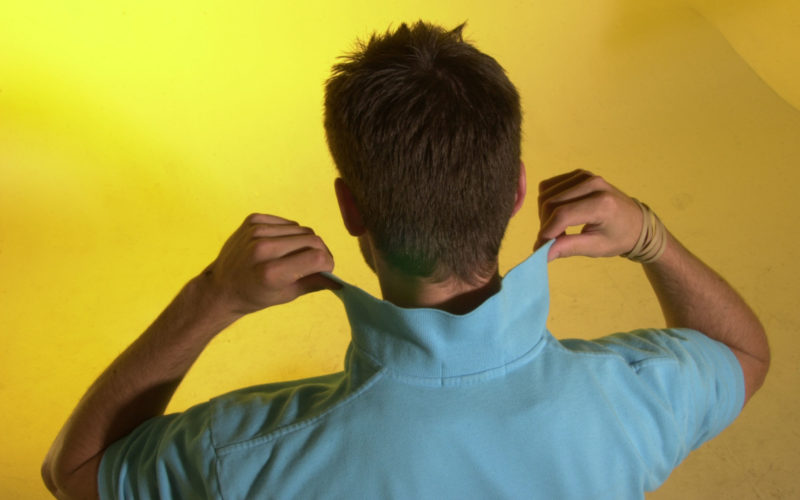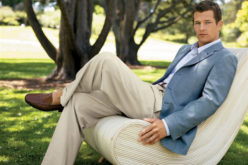Q. I recently read an article about the men’s style of wearing a “popped collar.” It referred to it as dated and described the look as uppity, snooty, and obnoxious. It made fun of men who wore it, accusing them of pomposity. I’m not sure I agree. What do you think?
A. I agree with you and believe that their attitude is much too “all or nothing.” Some styles work on occasion, and do not need to be totally discarded just because some people overdo it. Before we discuss when it works and when it doesn’t, I should clarify that a popped collar is the usually down-turn collar of a dress or polo-shirt being flipped up so that the underside is more visible that the top-side. It is never done with button-down shirts, and is not simply putting one’s collar over a crewneck sweater. It was particularly popular in dress shirts in the 1980s and grew to include polo shirts thereafter. Actually it originated nearly a century ago with Lacoste polos (more on that below). In recent decades it comes and goes in popularity, with popping the polos and dress shirts common as a “cool” urban look as well as popping the collar on casual outdoor jackets.
So, returning to when it works: if, for example, you own a good-looking patterned sport shirt that has another pattern on the underside of the collar, why wouldn’t you sometimes want to wear it with the collar popped so the second pattern shows? You probably bought the shirt at least partially because you liked that element of the design, so why not allow it to be visible?
To further explain how not everything you wear needs to be worn only one way, let’s consider the button-down collar Oxford cloth business/dress shirt. Certainly, this is versatile enough to be worn in a variety of different ways: 1. in its traditional preppy way with a quiet necktie and blazer; 2. with a suit and a dressier tie; 3. with a bowtie or a long four-in-hand tie; 4. unbuttoned and open-at-the-neck for a casual weekend look; 5. layered under a crewneck sweater, either with or without a tie, and 6. despite the fact that I personally dislike untucked shirts, another way is as an open jacket worn over a T-shirt. Each fills a different purpose and says something quite different about the wearer and his dressing style. As I mentioned above the only way a button-down collar shirt should not be worn is “popped up,” with the collar buttons unbuttoned. The buttoned look is essential to this style shirt and those two little collar buttons should always be fastened.
When we consider the history of the popped collar, we see it was first introduced on the tennis court, allowing players to shade their necks while playing. These tennis collars were made popular by René Lacoste, the French tennis player who created the polo shirt . . . a revolutionary sports design that pushed the old-fashioned starched shirts out of style and introduced a new, softer knit shirt that moves with the body. Though the upturned collar had its origins in sport, it soon became a fashion trend.
And the style may be making a comeback. Some men have a way of making otherwise odd wardrobe choices look sharp. Some men have always worn an upturned collar because it feels right for them. When David Beckham wore his striped rugby shirt with the collar popped, it looked really cool mainly because it was being worn by David Beckham. Looking back, this collar style was widely seen on celebrities like James Dean in “Rebel Without a Cause,” on Justin Bieber, and on the sharp-dressing guy next door who wore it every time he donned his khakis. In gangster movies from the 30s and 40s, mobsters wore it, so the turned-up collar seemed to be part of the style. Celebrity fashion is often used to tell us what we should be wearing.
Keep in mind that popped collars are for casual outfits, not for business. Whatever opinion people may have, this style shows no signs of disappearing entirely and there seems to be no real reason why it should. While the look may not be for everyone, that should not stop a man who likes it from wearing it on occasion. Keeping your own sense of style is what matters; it’s what lends your clothes their charm and individuality. If you like the look, if you’re comfortable wearing it, and don’t overdo it, then it’s right for you.
Please send your men’s dress and grooming questions to MALE CALL: Lois.Fenton@prodigy.net









